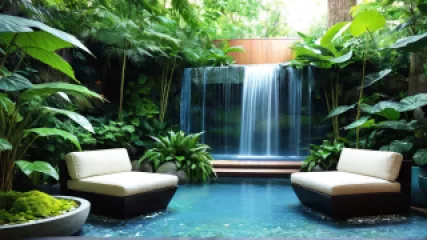10 Best Healing Environment Design Tips for Improved Mental Well-being
10 Best Healing Environment Design Tips for Improved Mental Well-being
Creating a therapeutic space that promotes mental well-being is a key consideration for mental health professionals, counselors, and those designing virtual or in-person environments for mental health support. The psychology of space and how it influences our emotions, cognition, and overall mental state is a fascinating field of study with important implications for healing and recovery. In this comprehensive list, we'll explore 10 of the best design tips to cultivate a healing environment that can tangibly improve mental well-being.
1. Incorporate Biophilic Design Elements
Biophilic design is the incorporation of natural elements, forms, and materials into the built environment. Numerous studies have found that exposure to nature, or even representations of nature, can have a profoundly positive impact on mental health and psychological restoration. Integrating biophilic design features such as living plants, natural lighting, water features, and organic textures can help reduce stress, improve mood, and foster a sense of calm and tranquility. These restorative natural elements can be particularly impactful in clinical or counseling settings where patients or clients may be experiencing heightened levels of anxiety or emotional distress.
2. Optimize Lighting for Mood and Circadian Rhythms
Lighting plays a critical role in shaping the ambiance and emotional tone of a space. Warm, soft lighting has been shown to promote feelings of relaxation and comfort, while bright, harsh lighting can contribute to tension and discomfort. Additionally, ensuring that the lighting in a healing environment is aligned with natural circadian rhythms can have profound benefits for mental health. Incorporating dimmable, circadian-friendly lighting that mimics the natural progression of daylight can help regulate sleep-wake cycles, boost mood, and enhance overall well-being.
3. Curate Calming Color Palettes
Color psychology is a well-established field, and the strategic use of color can significantly influence the emotional experience of a space. Soft, muted tones like blues, greens, and neutrals have been shown to promote feelings of calmness and relaxation, making them ideal choices for healing environments. In contrast, bold, stimulating colors like reds and oranges may inadvertently contribute to heightened arousal and stress. By carefully selecting a calming color palette, designers can create a serene and restorative atmosphere that supports mental well-being.
4. Foster Sensory Engagement
Engaging multiple senses can help create a more immersive and therapeutic experience. Incorporating elements that appeal to the senses, such as soothing sounds, pleasant aromas, and tactile surfaces, can help individuals feel more grounded and present in the moment. For example, the gentle sounds of flowing water, the scent of essential oils, or the soft textures of natural materials can all contribute to a heightened sense of calm and mindfulness.
5. Prioritize Privacy and Personal Control
Feeling a sense of privacy and personal control over one's environment is essential for mental well-being, especially in therapeutic settings. Designing spaces that offer a balance of private, semi-private, and communal areas can help individuals feel safe, comfortable, and empowered to regulate their own experience. Additionally, providing opportunities for personalization, such as adjustable lighting or seating arrangements, can further enhance a sense of ownership and control, which can be particularly beneficial for those seeking mental health support.
6. Encourage Movement and Physical Activity
Physical activity has been widely recognized as a powerful tool for improving mental health. Incorporating design elements that facilitate gentle movement, such as walking paths, yoga studios, or even indoor gardens, can help promote physical and mental well-being simultaneously. By encouraging movement and physical engagement within the healing environment, designers can create spaces that nurture both the body and the mind.
7. Leverage Spatial Acoustics
The acoustic properties of a space can have a significant impact on the overall atmosphere and emotional experience. Thoughtful acoustic design, such as the use of sound-absorbing materials, can help create a sense of quiet and tranquility, reducing the impact of disruptive noises and promoting a more peaceful environment. Additionally, the strategic placement of sound-masking elements, like water features or nature-inspired audio, can help create a soothing auditory backdrop that supports mindfulness and relaxation.
8. Enhance Wayfinding and Spatial Orientation
Clear and intuitive wayfinding can greatly contribute to a sense of comfort and control within a healing environment. Effective signage, visual cues, and spatial organization can help individuals easily navigate the space, reducing feelings of disorientation or anxiety. By designing environments that are easy to understand and move through, mental health professionals can create a more welcoming and supportive setting for their clients or patients.
9. Foster Social Connections and Community
While privacy and personal control are important, social interaction and a sense of community can also play a vital role in mental well-being. Incorporating design elements that encourage social engagement, such as shared gathering spaces or flexible seating arrangements, can help foster a sense of belonging and support. This can be particularly beneficial for those seeking mental health services, as it can provide opportunities for peer support, group therapy, or simply meaningful social connections.
10. Embrace Flexibility and Adaptability
The needs and preferences of individuals seeking mental health support can vary significantly. Designing healing environments with a high degree of flexibility and adaptability can help ensure that the space can be tailored to meet the unique requirements of each person. This may include the ability to adjust lighting, furniture, or spatial configurations to accommodate different activities, therapeutic modalities, or personal preferences. By embracing a flexible and adaptable approach, designers can create healing environments that are truly responsive to the diverse needs of those they serve.
In conclusion, the design of healing environments has a profound impact on mental well-being. By incorporating these 10 best practices, mental health professionals, counselors, and designers can create spaces that foster a sense of calm, comfort, and restoration, supporting the overall mental health and well-being of those who utilize them. Whether in-person or virtual, the strategic application of these design principles can help cultivate a truly therapeutic and restorative space.






